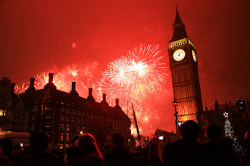Yuga
|
Greek
Period
|
Yuga
Duration
|
Dates (2000
AD)
|
Personage
|
| Satya |
Gold |
1,728,000 |
3,893,100 |
Noah (Manu
5.0) |
| Treta |
Silver |
1,296,000 |
2,165,100 |
Asuramaya |
| Dvapara |
Bronze |
864,000 |
869,000 |
Menes (Manu 5.2)
|
| Kali |
Iron |
432,000 |
3,102 BC |
Kali Yuga 5th
R.R. |
The Four Yugas of the Fifth
Rootrace
Readers can observe where
the Satya or Krita age ends (2,165,100 years), about one million years before
the start of the first (Hindu) subrace of the Fifth Rootrace. The death of
Krishna was supposed to have heralded the Kali Yuga and there may well
have been a Krishna (as there have been many Buddhas) in 3,102 BC.
But the Krishna referred to in The Mahabharata heralded the Kali
Age of the (Fourth) Atlantean race a few million years ago. The date of 3,102 BC
is the Kali Yuga of this, our Fifth (Aryan) Rootrace. This fact has caused
confusion amongst scholars and is partially responsible for Hindu and Western
pundits diminishing the time-scales of the Hindu scriptures. Regarding
Asuramaya, H.P. Blavatsky says:
"The best and most complete of all such
calendars, at present, as vouched for by the learned Brahmins of Southern India,
is the already mentioned Tamil calendar called the “Tirukkanda Panchanga,”
compiled, as we are told, from, and in full accordance with, secret fragments of
Asuramâya’s data. As Asuramâya is said to have been the greatest astronomer, so
he is whispered to have also been the most powerful “Sorcerer of the
WHITE ISLAND, which had become BLACK with sin,” i.e., of
the islands of Atlantis.
The “White Island” is a symbolical
name. Asuramâya is said to have lived (see the tradition of Jhána-bhaskara) in
Romaka-pura in the West: because the name is an allusion to the land and
cradle of the “Sweat-born” of the Third Race. That land or continent had
disappeared ages before Asuramâya lived, since he was an Atlantean; but he was a
direct descendant of the Wise Race, the Race that never dies.
Many are the legends concerning this hero, the pupil of Surya (the Sun-God)
himself, as the Indian accounts allege … Asuramâya, “as great a magician as he
was an Astrologer and an Astronomer.””
The ‘third race’ is of course one of the latter subraces of
the (third) Lemurian Rootrace, from where the Hindus and Egyptians have their
ancient genesis. (More on the ‘Wise Race’ later.) Due to the deterioriation of
the Atlanteans, what were once divine names of the Asuras in that race gradually
became applied to those who had abused their god-given powers
until,
“Asura was the generic appellation
of all the Atlanteans who were the enemies of the spiritual heroes of the Aryans
(gods).”The word Asura comes
from Surya, Sanskrit for the sun; Asuramaya learned his art from studying and
meditating upon the Sun. In the Yoga Sutras of Patanjali it is said that,
“Through meditation, one-pointedly fixed upon the sun, will come a consciousness
(or knowledge) of the seven worlds.”
Maya is
illusion, particularly in its densest manifestation upon the physical plane, the
most powerful domain of the sorcerers of those days. All these events were
occurring at the time of the gradual emergence of the Fifth (Aryan) Rootrace and
the conflicts between the old and new races went on for some few million years
after the original Mahabharata.
It is interesting to note that The
Lord of the Rings is a story gleaned by J.R.R. Tolkien from our racial
memory and is probably a fairly accurate account of those Atlantean days of war,
monsters, giants, angels and magic. The chief sorcerer against whom Gandalf (the
White) fights is Saruman, whose name is virtually an anagram of Asuramaya. The
Hobbits are of course, Humanity and perhaps their six toes on either foot
represent the coming Sixth Rootrace! In the emerging new race Asuramaya had his
counterpart (and mentor) in Narada or ‘Pesh-Hun’, the old Vedic Rishi from whom
he learned all, a highly elevated Mercurial type:
“… in Hindu
Esotericism, Narada—who is called in Cis-Himalayan Occultism Pesh-Hun,
the “Messenger,” … is the sole confidant and the executor of the universal
decrees of Karma … who leads and guides human affairs from the beginning to the
end of the Kalpa. “Pesh-Hun” … is the mysterious guiding intelligent power,
which gives the impulse to, and regulates the impetus of cycles, Kalpas and
universal events. He is Karma’s visible adjuster on a general scale … Narada …
surpasses Garga’s Guru in his knowledge of cyclic intricacies. It is he who has
charge of our progress and national weal or woe. It is he who brings on wars
and puts an end to them. In the old Stanzas Pesh-Hun is credited with having
calculated and recorded all the astronomical and cosmic cycles to come, and with
having taught the Science to the first gazers at the starry vault. And it is
Asuramâya, who is said to have based all his astronomical works upon those
records, to have determined the duration of all the past geological and cosmical
periods, and the length of the all the cycles to come, till the end of this
life-cycle, or the end of the seventh Race.
There is a work
among the Secret Books, called the “Mirror of Futurity,” wherein all the Kalpas
within Kalpas and cycles within the bosom of Sesha, or infinite Time, are
recorded. This work is ascribed to Pesh-Hun Narada. There is another
old work which is attributed to various Atlanteans. It is these two Records
which furnish us with the figures of our [The Hierarchy] cycles, and the possibility of
calculating the date of cycles to come …
The chronology and computations of
the Brahmin Initiates are based upon the Zodiacal records of
India, and the works of the above-mentioned astronomer and
magician—Asuramaya. The Atlantean zodiacal records cannot err, as they were
compiled under the guidance of those who first taught astronomy, among other
things, to mankind.”Note one of Narada’s appellations
is ‘The Messenger’ equivalent to Mercury, Hermes or the Egyptian Thoth. (Note
the earlier reference to the Mayans coming from the ‘Naga
tribe’.)The Mayans: Master
AstronomersAs noted earlier, The studies focused on the
calendars of the two advanced civilizations. The Indus Valley inhabitants
followed a calendar based on the movements of Jupiter, and the Mayans
followed one based on the Venus. In the Puranas, a secondary Hindu
scripture, Jupiter, Brihaspati, was acknowledged to be the leader of the gods,
while Venus, Shukra, was the leader of the asuras.”
The Mayans are
well known for their astronomical accuracy through their studies of the cycles
of Venus, yet their whole system of astronomy and cycles derives from their
ancient Hindu past:
“Modern students of the ancient
Mayan numerical glyphs have found that the dating of major series of events
noted on Mayan stelae invariably give such reckonings in terms of the time
elapsed since a date
known as 4 Ahau 8 Cumhu. They know that for the Maya chroniclers this date
represented a commencement point in time-reckoning of such awesome magnitude
that it was central to all else in subsequent Maya history; but they don't know
what it meant or why it was so important to the latter. Among other ancient
nations only one, the Hindu peoples of the Indian subcontinent, is known to have
developed a system of calendrics accounting for such vast periods of time. For
computing the age of the earth and various geological and other epochs, as well
as the age of mankind, the learned Brahman caste still employs a Tamil calendar
derived from archaic astronomical data, known as the "Tirukkanda Panchanga"
(The Secret Doctrine, II:49-51).”
Other diverse commentators corroborate these
facts:
"The Mayan culture flourished in Mesoamerica during the
early Christian era, before being completely wiped out by the Spanish conquest.
Astronomy played a significant role in Mayan culture. Venus in particular had a
pre-eminent status. Testimony to this rich tradition is borne out by Mayan
temple art and the few available Codices, or sacred books, of the Mayans.
Western scholars have attempted to relate the Mayan concepts to those of Greek
astronomy. The sidereal Mayan astronomy is more akin to the Hindu system and
does not easily fit into the Greek model.”
The theories about Greek astronomy are related to the misapprehension of
cycles by historians and researchers down the ages – both east and west. Greece
is a much more modern and recent culture, India and the Mayans are very
ancient. Confusion has arisen do to cross fertilisation of ideas between Greece
and India in the past few thousand years, as well as the ‘Greek-centric’ view
held by many western historians.
”Striking similarity is found between
certain Mayan and Puranic stories, and their related astronomical
interpretation. In the Puranas, Lord Vishnu is represented as resting on the
serpent Ananta or Sesa, after having dissolved all creation. The serpent
represents the eternity of time (Ananta), and the "remainder" (Sesa) in subtle
form, of prakriti, the germ of all that has been and will be. After waking up
from the yoganidra, Vishnu rides on the eagle Garuda. Both Garuda and Sesa are
shown in association with Vishnu in the temples of India. It is
said that Garuda represents the Vedas and the solar deities, and Sesa represents
the watery deities. The serpent [Naga] is of great significance in the Mayan
culture also. A supreme example is the serpent of sunlight and shadow seen at
Chichén Itzá. At the time of the equinoxes, as the Sun moves from east to west,
a pattern of light and shadow appears on the west balustrade of the north
stairway of the Castillo at Chichén Itzá. This display resembles a descending
snake whose head is the monumental serpent head carved out of stone at the foot
of the stairs. The feathered serpent represents the Mayan God Kukulcan, who is
associated with rain water and new life, among other things. Kukulcan appears to
be Sesa and Garuda combined into one.”
"In the book The Conquest of the Maya by J.
Leslie Mitchell, he explains that the basis of the old Maya empire was not of
the work of the ancestors of the present day Maya, but was an import from the
same foreigners that built the palaces and temples of the Chams and Khmers in
Cambodia, and the temples in Java. He also points out the similarities between
the Maya rain-god Chac and the Vedic Indian Indra, and the Maya monkey-god and
the Vedic Hanuman. The Vedic origin is further enhanced by the frequency that
the elephant motif is found in Maya art, especially the earlier works of the
Maya, such as at Copan, although the elephant never existed in the region.”
The
reader will note that the temples of Cambodia are commented upon in the
newsletter “Ancient Cambodia: Angkor Wat and the Egyptian Connection.” (www.esotericastrologer.org/EA%20Essays/40%20Esoteric%20History%20I.htm)
The
ancient Khmer (Cambodian) culture probably belongs to the second subrace of the
Fifth Rootrace (5.2), the same as the Egyptians and Mayans, but of a different
branchrace lineage. One is reminded of the vast extent of the Indian
empire that stretched from South East Asia to Persia
(Iran); it also extended southward to the old Tamil country, since
sunk.
"One
reason for these similarities between the Americas and India is that in ancient
Vedic times there were two great architects, Visvakarma of the demigods or
Aryans, and Maya of the asuras. Surya Siddhanta was revealed to Mayasura by Sun.
The Mayan people, also known as technicians, were no doubt named as such because
of being connected with this person named Maya or Mayasura and Maya Danava. They
were a part of his clan or tribe. They had fallen away from the Vedic way of
life and were sent or escaped to the region of Central America.
They also carried with them much of the science of astronomy and navigation for
which this Mayasura was known. Mayasura’s knowledge is more fully explained in
the classic work of Indian Vedic astronomy known as the Surya Siddhanta for
which he is given credit. Many people have wondered from where the Mayan
acquired their astronomical knowledge. This would explain how the Mayan people
had such a high degree of understanding in astronomy, from which they also
developed their calendar. The Mayan calendar was a science they had long
developed, carrying it with them from their previous location and
civilization.”
Note the reversal of
Asuramaya’s name but the same historical details are intact. The Mayans were
known as ‘technicians’ a very interesting word that denotes strong influence of
the Fifth Ray of Science, which of course is related to astronomy. This ‘fifth
aspect’ not only corresponds to the Fifth Rootrace and ‘fifth continent’
mentioned earlier but to possibly a fifth branchrace (clan/tribe) ‘signature’
such as 5.2.5 – the 5th branchrace of the second subrace of the Fifth
Rootrace.
The second
subrace of the Fifth Rootrace (5.2) came forth around 860,000 years ago– at the second great Atlantean flood
and coincident with the migration from India that established the Egyptian
civilisation on the Nile.

Atlantean Islands
This
map is one of many speculations of the location of the Atlantean islands. It has
been included to illustrate how it would not have been very difficult for the
ancient Mayans (renowned mariners), to ‘island hop’ their way across the
Atlantic from Africa to where Guatemala is today; if they came the same
route as the Egyptians from India and kept heading west.
"Like
the Vedic culture, the Maya had a pantheon of demigods, many of which have
similarities to the Vedic deities. Mayan gods like Xiuhtechutli and Xipe Totec
have their Vedic counterparts in Indra and Agni. Indra, like Xiuhtechutli, was
the rain god and guardian of the Eastern Quadrant, and Agni, similar to Xipe
Totec, was the god of sacrificial fire, born in wood and the life force of trees
and plants. Then there is the Vedic Ushas, the beautiful goddess of Dawn or Sky,
who is similar to the Mayan view of Venus, goddess of Dawn … Furthermore, hymn
121 of the book ten in the [Hindu] Rig Veda is very similar to the description
of creation as found in the [Mayan] Popul Vuh.”
None
of this pantheon of gods would be complete without the legendary
Quetzalcoatl:
”A Mesoamerican Christ: Quetzalcoatl is to the New
World what Christ is to Europe [or Krishna to
India]: the center of a religious cosmology and the pre-eminent
symbol of the civilized nations of Mesoamerica. Both were
considered to be men who ascended into heaven upon their death; Christ to sit at
the right hand of God, Quetzalcoatl to become the Morning Star [Venus]. Both
were tempted by evil powers; Christ by Satan, Quetzalcoatl by the wizard-god
Tezcatlipoca. And both were prophesied to one day return to earth, Christ as the
Prince of the Kingdom of Heaven, Quetzalcoatl as a god-king
returned to claim his kingdom in Central Mexico. To understand the life
and teachings of Jesus Christ is to understand Christianity, the root religion
of what we refer to as Western Civilization. To understand the life and mystery
of Quetzalcoatl is to understand the religious thought of what we call
Mesoamerica.”

Quetzalcoatl
Courtesy: hiddenhistoryhumanity.com

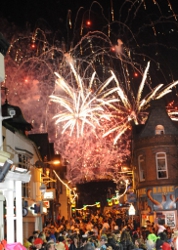
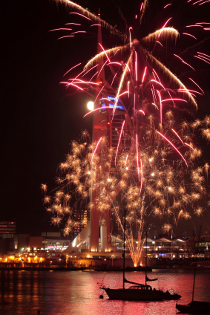 Spinnaker Tower fireworks
Spinnaker Tower fireworks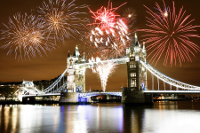 Fireworks over River Thames
Fireworks over River Thames Wonderland
Wonderland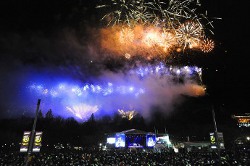 Edinburgh's Hogmanay
Edinburgh's Hogmanay